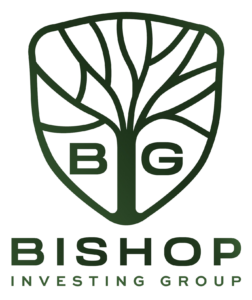
Learning how to invest $250K effectively opens up various avenues for financial gain. Such an amount has the potential to create passive income, increase your personal net worth, and ensure long-term financial security. However, with such a significant initial investment, the sheer array of investment options can be overwhelming. Common investment pitfalls usually stem from a lack of information or analysis of too much information which usually makes it difficult to make sound investment decisions.
Bishop Investing Group hopes to simplify the complex world of investing by providing clear insights into investing an amount like $250,000. If your investment budget is slightly lower, then maybe a guide on how to invest $100K will suit your quest for information a little better. Investors with bigger appetites and comparable budgets can engage with Bishop Investing’s guide for investing $500K
We’ll look at investment opportunities, demystify mutual funds, and the importance of maintaining an emergency fund. We’ll also explore alternative sources of income and the potential role they can play in a diversified portfolio. By understanding these concepts, you’ll be able to optimize your $250K investment effectively, ensuring financial growth, security, and stability.
Preparing for Investment

Before investing a significant sum like $250K, thorough preparation is required. This first step toward financial freedom begins with understanding your risk tolerance. Risk tolerance is your ability and willingness to lose some or all of your original investment in exchange for greater potential returns. An individual with a high-risk tolerance might feel comfortable investing in real estate syndications or the stock market, while those with a lower risk tolerance might prefer safer investments like bonds.
A financial advisor can be instrumental in evaluating your risk tolerance, financial goals, and crafting a personalized investment strategy. They can guide you in understanding complex financial scenarios, potential tax liability, and the impact of fluctuating interest rates on your investment. They can also assist you in setting up appropriate accounts for investing.
An important part of preparation is to consider the type of account you’ll use for your investments. Tax-advantaged accounts like Individual Retirement Accounts (IRAs) or 401(k)s can offer significant benefits. However, a conventional brokerage account might give you more freedom to access your money when you want.
Assessing your current financial status is another crucial part of the preparation phase. Paying off high-interest liabilities, such as credit card debt, should be a priority. High-interest debt can quickly eat into your monthly income and any potential returns from your investment, hindering your journey toward financial freedom.
Lastly, it’s essential to educate yourself about various investment avenues. For example, investing in real estate can provide consistent cash flow through rental income and potential appreciation of the property over time. Real estate syndication is an increasingly popular way for multiple investors to pool their financial resources to invest in properties and projects much bigger than they could afford individually. It offers another potential investment option for investors seeking passive investment opportunities.
Preparation is a vital step in your investment journey. It sets the stage for the investment actions you’ll take going forward. Thorough preparation can be the difference between achieving financial freedom and facing financial difficulties.
Basics of Diversification and Asset Allocation

The foundations of a solid investment strategy lie in understanding two fundamental concepts: diversification and asset allocation. These principles can help mitigate potential risks, ensure a steady income, and optimize potential returns.
Diversification Explained
Diversification is a risk management strategy where you spread your investment across various asset types to reduce exposure to any single asset or risk. The old saying, “Don’t put all your eggs in one basket,” holds particularly true in investing. By diversifying, you are essentially protecting yourself against significant losses.
For instance, if you solely invest in real estate and the property market dips, your entire portfolio suffers. However, if you’ve also invested in the stock market or mutual funds, the potential losses in real estate could be offset by gains in these other areas. Diversification, however, doesn’t assure profit or protect completely against loss in declining markets.
What Is Asset Allocation?
Asset allocation, on the other hand, is how you divide your investment among different asset categories like stocks, bonds, and cash or cash equivalents like an emergency fund. The aim here is to balance risk and reward by adjusting the percentage of each asset in your portfolio according to your risk tolerance, goals, and investment timeline.
For instance, if you have a high-risk tolerance and a long time horizon before needing your investment back, you might choose to allocate a higher percentage of your portfolio to stocks. If you prefer a steady income stream with lower risk, you might decide to allocate more toward bonds or investment properties that generate rental income.
It’s important to note that diversification and asset allocation don’t ensure profits or protect against losses, but they are time-tested strategies that can help you manage risk.
Investment Options for $250K
Now that you are ready to invest, let’s look at the options at your disposal for a $250k amount. There could be thousands of opportunities available for you considering your initial investment. The ones in this section are some of the common types.
Investing in the Stock Market

Investing in the stock market is one of the most traditional and popular investment options. An understanding of this market’s intricacies is vital for anyone looking to solidify their financial future. While the idea of investing in individual stocks may seem straightforward, various factors can affect investment returns and therefore, must be understood thoroughly.
First, stock market volatility is a constant factor to consider. The prices of stocks rise and fall based on a multitude of factors including the financial health of companies, economic indicators, and global events. For instance, news of a sudden political upheaval in an oil-producing country can lead to a drop in oil stocks worldwide. Therefore, part of your investment strategy must involve monitoring these events and their potential impact on your investment portfolio.
However, this volatility also creates opportunities. Savvy investors often find undervalued stocks during market downturns. Purchasing these stocks at lower prices can result in significant returns once the market recovers. Thus, turning market volatility into an opportunity, rather than a risk, requires careful planning, keen observation, and in many cases, expert investment advice.
Bond Investments

Investing in bonds is another viable strategy to grow your wealth. The nature of bonds makes them an excellent choice for many investors looking to achieve their investment goals while minimizing risk. This approach may particularly appeal to you if you are uncomfortable with putting such a big amount as $250K into riskier assets like stocks.
Bonds are essentially loans that investors provide to entities such as governments or private companies. In return, these entities promise to repay the borrowed amount (or principal) after a specific period (maturity date), along with periodic interest payments. These payments can help you earn passive income and provide a predictable return on your investment.
One of the main advantages of bonds is their relatively lower risk compared to stocks. When you buy company stock, your return depends entirely on how well the company performs. However, with bonds, the issuer is obligated to repay the bond’s face value at maturity, regardless of their financial situation. This repayment guarantee, unless the issuer defaults, makes bonds a safer investment, especially if you’re not comfortable with how much risk you can take.
Bond funds managed by a professional management company can provide an easy way to invest in a diversified portfolio of bonds. The management company does the research, selects the bonds, and manages the portfolio on your behalf. This approach allows you to invest a lump sum in various bonds, reducing the risk associated with investing all your money in a single bond issue.
Moreover, certain types of bonds can offer tax advantages. For instance, interest earned on municipal bonds is usually exempt from federal taxes and sometimes state and local taxes, which can significantly reduce your tax bill.
Mutual Funds and ETFs

When contemplating how to invest $250k, some investors may gravitate toward Mutual Funds and Exchange Traded Funds (ETFs). These investment vehicles can offer diversification, professional management, and ease of investment, which can be especially appealing if you’re unsure about investing in individual stocks or bonds.
Mutual funds and ETFs pool money from many investors to invest in a diverse portfolio of assets. These can range from stocks and bonds to precious metals, growth stocks, or even specific sectors like technology or healthcare. Some funds focus on index investing, where they seek to replicate the performance of a specific index like the S&P 500. These index funds typically have lower fees as they require less active management.
Diversification is one of the main benefits of these funds. Rather than putting all your money into one asset class, mutual funds and ETFs provide exposure to a broad range of assets. This diversification can lower risk as poor performance by one asset can be offset by a strong performance by another.
Investing in mutual funds and ETFs can also be advantageous from a capital preservation perspective. As you near retirement age, you may want to focus more on preserving your capital and generating income rather than seeking high growth. Certain mutual funds and ETFs focus on income-generating investments, such as dividend-paying stocks or bonds, which can provide regular income to cover living expenses in retirement.
Generally, mutual funds and ETFs offer an easy and efficient way to diversify your investment portfolio, balance growth with capital preservation, and manage risk. Whether you’re planning for retirement or looking to generate income, these investment vehicles can be an effective part of your overall strategy on how to invest 250k. However, as with all investments, understanding your financial goals, risk tolerance, and market dynamics is key to successful investing.
Investing in Retirement Accounts
Investing for retirement is a crucial part of any comprehensive investment plan. Retirement accounts provide a tax-advantaged way to save and grow your money, helping you amass a larger nest egg for your golden years.
There are several types of retirement accounts to consider. Traditional Individual Retirement Accounts (IRAs) and 401(k) plans, for example, allow you to contribute pre-tax dollars. The money grows tax-free, but you’ll have to pay taxes when you withdraw it during retirement.
Roth IRAs and Roth 401(k)s, on the other hand, involve contributions with after-tax dollars. While you don’t get a tax break when you put the money in, all the growth and withdrawals during retirement are tax-free. This can be particularly beneficial if you anticipate being in a higher tax bracket when you retire compared to your current situation.
When you’re deciding how to invest your 250k, maximizing contributions to these retirement accounts can be a smart move. Not only do you get the benefit of tax advantages, but your money also grows over time through the power of compounding. The earlier you invest, the more time your money has to grow, meaning you’ll end up with more money for retirement.
Alternative Investments
Alternative investments are generally outside traditional financial instruments like stocks, bonds, or cash. They encompass a wide range of assets, cryptocurrencies, commodities, hedge funds, private equity, NFTs, and even artwork or antiques.
When used correctly, alternative investments can provide several benefits. They can offer diversification as their performance often does not correlate directly with traditional markets. This uncorrelated performance means that when stocks or bonds perform poorly, your alternative investments may still provide positive returns, reducing the overall volatility of your portfolio.
A popular alternative investment option is commodities. Popular commodities like gold, oil, or agricultural products can offer a hedge against inflation. When inflation rates are high, the prices of these commodities typically increase, providing investors with protection against the eroding purchasing power of money.
However, investing in these alternatives isn’t without risks. Many of these investments are not as liquid as traditional ones, meaning you can’t easily sell them for cash. Moreover, some alternatives like hedge funds or private equity often require a substantial initial investment and may be out of reach for individual investors. Due diligence is crucial when venturing into the world of alternative investments.
It’s also worth noting that, as with all investment strategies, maintaining an emergency fund should be part of your plan. An emergency fund is a reserve of cash set aside to cover unexpected expenses. By having this financial cushion, you ensure that you don’t have to liquidate your investments, whether traditional or alternative, prematurely in the event of an emergency.
A Detailed Exploration of Real Estate Investing

Real estate investing is an excellent avenue to consider when strategizing how to invest $250k. It offers multiple paths toward generating wealth, each with its unique potential benefits, risks, and challenges. Real estate investing is a strategy that involves purchasing properties to generate a return on investment. This return can be produced through rental income, the resale of the property after its value increases, or both. It’s a diverse field that encompasses various types of properties and strategies, each with its own risk and reward profiles. Let’s explore some common investment options in real estate:
Real Estate Syndication
This is a partnership between several investors who pool their resources to invest in properties and projects bigger than they could afford or manage individually. In a real estate syndication, one or more individuals or entities (the syndicators or sponsors) will identify an investment opportunity, structure the investment, and offer it to other investors (the investors or limited partners).
The syndicator typically manages the project, while the investors provide the bulk of the capital. This setup allows accredited investors to participate in larger, potentially more profitable deals while spreading the risk. However, investors must trust the syndicator’s expertise and ability to manage the project effectively.
As with any investment, diversification is key – spreading your funds across various types of property investments can help reduce risk and increase potential returns. Remember to account for the impact of interest rates, property taxes, and other costs that may affect your return on investment. Real estate investing has the potential to provide an excellent source of passive income, especially if it is part of a balanced, well-diversified investment strategy.
The professionals at Bishop Investing Group today can guide you through available opportunities in syndication to support you in building passive generational wealth. Get in touch with our team to learn more!
Rental Properties
This is perhaps the most straightforward type of real estate investing, where you purchase a property and rent it out to tenants. The main goal here is to generate a positive cash flow from the rental income, which, after subtracting all costs and expenses, provides a steady stream of passive income. However, it’s crucial to account for expenses such as maintenance, property taxes, and periods of vacancy. Your cash flow is also affected by interest rates if you’re leveraging your investment with a mortgage.
Real Estate Investment Trusts (REITs)
Real Estate Investment Trusts, or simply REITs own, finance, or manage income-generating real estate. By investing in a REIT, you can earn a share of the income produced without having to buy or manage the property yourself. This method is a more hands-off approach to real estate investing but bear in mind that REITs are subject to market fluctuations, much like stocks.
House Flipping
This type of real estate investing involves buying a property, typically in need of repairs or updates, improving it, and then selling it for a profit. It’s a more active form of investment that requires a good understanding of the real estate market, construction costs, and a keen eye for assessing property potential. It can be highly profitable but also carries higher risk and requires more capital and effort.
Why Some Investors Favor Real Estate over Other Types of Investment Opportunities
Attractive Tax Benefits
Real estate investment comes with a variety of tax benefits that can significantly improve your returns. Here’s a closer look at some of these benefits and how they work:
Mortgage Interest Deductions
If you have a mortgage on your investment property, the interest you pay on your mortgage is tax-deductible. For example, if you have a $200,000 mortgage with a 5% interest rate, your annual mortgage interest would be $10,000. This amount can be deducted from your taxable income, potentially saving you a significant amount in taxes.
Depreciation Deductions
The IRS allows real estate investors to deduct the cost of their investment property over a set number of years through depreciation. For residential properties, the period is 27.5 years, and for commercial properties, it’s 39 years. For instance, if you buy a residential rental property for $275,000, you can claim a depreciation expense of $10,000 ($275,000 / 27.5) each year for 27.5 years. This reduces your taxable income, saving you money on taxes each year.
Repair and Maintenance Deductions
Costs to repair and maintain your rental property are tax-deductible. These can include everything from small repairs to large improvements. For example, if you spend $2,000 on a new water heater and $3,000 repainting the property, you can deduct these costs from your taxable rental income for that year.
Property Tax Deductions
Property taxes paid on your rental property are fully deductible from your taxable income. If your annual property tax bill is $3,500, this amount can be deducted from your rental income when calculating your taxable income.
1031 Exchange
This is a tax deferment strategy for property investors. If you sell an investment property and use the proceeds to buy a similar (or “like-kind”) property, you can defer paying capital gains taxes on the sale. This allows you to use the full amount of the sale to invest in another property.
For example, if you sell a rental property for $500,000 that you originally bought for $300,000, you would typically have to pay capital gains tax on the $200,000 profit. However, if you use that $500,000 to buy another rental property or invest in a syndication using a 1031 Exchange, you won’t have to pay taxes on the $200,000 gain until you sell the new property without reinvesting in another one.
It’s important to note that tax laws can be complex and are subject to change, so it’s a good idea to consult with a tax professional or real estate accountant who can help you navigate these issues and ensure you’re taking full advantage of the tax benefits available to you.
Tangible Asset Value
Investing in real estate gives you ownership of a physical asset. For instance, if you buy a share of a company, you’re buying a piece of the business, but you don’t have control over its operations or decisions. In contrast, when you buy a rental property, you own the physical building and land. You can touch, see, and make decisions about the property. During economic downturns, even if property values fall, you still own a tangible asset that doesn’t disappear like a company can if it goes bankrupt.
Appreciation
Real estate appreciation is the increase in a property’s value over time. For example, if you bought a house in Austin, Texas, for $200,000 in 2010, it could be worth as much as $400,000 in 2023 due to the city’s rapid growth and increased demand for housing. This appreciation in value can result in a significant return on your investment when you decide to sell.
Rental Income
Rental income is a significant benefit of real estate investing. Let’s say you purchase a duplex for $250,000 in a desirable area. You live in one unit and rent out the other for $1,200 per month. That’s $14,400 in rental income per year, which can cover your mortgage payments and potentially result in profit.
Cash Flow:
Cash flow is a significant benefit of real estate investing, often serving as the primary reason many investors choose to invest in this sector. In essence, cash flow refers to the net income generated from a rental property after deducting all expenses. These expenses may include mortgage payments, insurance, property taxes, maintenance costs, property management fees, and any other costs associated with owning and maintaining the property. The remaining income can be saved, reinvested, or used to cover living expenses.
For example, let’s consider a scenario where you’ve purchased a rental property for $250,000, putting down a 20% down payment ($50,000) and financing the remaining amount. Assuming your monthly mortgage payment (principal and interest) is $1,000, and your other monthly expenses (including property taxes, insurance, and maintenance) amount to $500, your total monthly expenses would be $1,500.
Now, let’s say you can rent this property for $2,200 per month. After subtracting your monthly expenses of $1,500 from the rental income, you’re left with a positive cash flow of $700 per month, or $8,400 per year. This income can be utilized to pay down the mortgage faster, saved for future investments, or used to enhance your lifestyle.
Furthermore, as a property owner, you can increase your cash flow over time. This can be achieved through measures such as rent increases in line with market trends, reducing expenses by negotiating better service rates, implementing energy-saving measures, or adding value to the property to command a higher rent.
The regular income generated from positive cash flow properties makes real estate a favored investment choice for those seeking steady income streams. Nevertheless, it’s critical to conduct thorough research or work with experienced professionals when selecting and managing rental properties to ensure positive cash flow and return on investment.
Hedging Against Inflation
One significant advantage of real estate investing is its ability to serve as a hedge against inflation. In economics, inflation is the rate at which the general level of prices for goods and services is rising, and subsequently, purchasing power is falling. Essentially, as inflation increases, every dollar you own buys a smaller percentage of a good or service.
However, real estate often reacts proportionately to inflation. As the cost of living increases, so too does the amount that renters are willing to pay for their accommodations and the amount that buyers are willing to pay for their properties. This unique feature allows real estate investors to maintain the purchasing power of their capital by passing along rising costs to tenants in the form of higher rents.
For instance, suppose you purchase a rental property today for $250,000, and you’re able to charge $1,200 per month in rent, giving you an annual rental income of $14,400. Let’s say inflation averages 2% per year for the next five years. As a result, you might be able to increase your monthly rent to approximately $1,323 after these five years, aligning with the rate of inflation. This increase in rental income helps preserve the purchasing power of your income, offsetting the effects of inflation.
Moreover, as prices rise, the replacement cost of properties also increases, pushing up the value of existing buildings. This is why real estate properties tend to appreciate over time, which is another way real estate can hedge against inflation. By contrast, those with cash savings or fixed-income investments, like bonds, typically see the purchasing power of their capital eroded during inflationary periods. These types of investments do not provide the same inflation protection as real estate.
Would you like to Invest $250K?

Bishop Investing Group would like to hear from you. Talk to us about your investment journey and your financial goals. We aim to create a sustainable and less time-intensive investing environment for our partners. Our team identifies and thoroughly assesses property assets that have the potential to yield attractive and risk-adjusted returns, before presenting it as an opportunity to you for investment consideration.
Do you have any questions concerning real estate investing strategies like identifying lucrative syndication deals? There is valuable market information on Bishop Investing’s resource page. If you are ready to leap into real estate investing and would like a knowledgeable and experienced partner by your side, please schedule a call with Michael Bishop today. He has invaluable market insight and an interesting asset portfolio, providing investors with the opportunity to build wealth passively.
DISCLAIMER:
Real estate investing comes with a variety of risks including rising interest rates, lower than expected occupancy and the operator’s failure to execute the renovation and rental increase business plan. Real estate investments are also illiquid which means there is no readily available market for an investor to sell their interest in a real estate syndication. Investors are typically required to be deemed an accredited investor. As with any investment, there is the risk that the entire investment may be lost.



